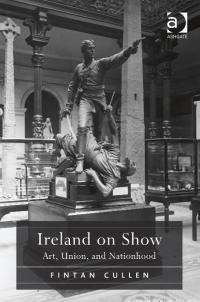Ireland on show: art, union and nationhood
Published in 18th–19th - Century History, 20th-century / Contemporary History, Book Reviews, Issue 5 (Sept/Oct 2012), Reviews, Volume 20
Ireland on show: art, union and nationhood
Fintan Cullen
(Ashgate, £58.50)
ISBN 9781409430191
Jubilees just aren’t what they used to be. In June 1897 Maud Gonne organised a counter-campaign of defiance to the official celebrations, a magic lantern projection from the National Club in Dublin. Which Ireland was on show that evening, in a capital illuminated with giant ‘VR’ monograms? Beamed across what is now Parnell Square were photographs of tenant cottages, roofs collapsed and doors barred, the battering ram omnipresent. Cullen speculates that these eviction scenes were from the famous set taken by the firm of William Lawrence, a rich source that he exploits well to support this and other arguments. Used effectively in this medium as political propaganda, they became potent visual onslaughts on British imperialism, and indeed on the very person of Victoria. The relevant chapter of this book, an erudite exploration of a neglected aspect of Irish cultural life in all its complexities before the founding of the Free State, is aptly entitled ‘Displaying distress’. This latest of Fintan Cullen’s insightful works on the visual history of Ireland is a fascinating study of what was displayed, and how it was displayed, by various institutions from the establishment of the Royal Hibernian Academy in 1823 to the controversial Hugh Lane bequest of 1908. Within this crucial time-span (pivotal to the formation of many national identities), the book also discusses ‘what was visible regarding Ireland’ within the Union and Britain, and devotes a thought-provoking chapter to the visual narrative of Irish integration in America beyond the traditional despondency. Moving beyond museums and the fine arts, many types of visualisations of Irishness are contextualised, even the rosy, buxom and skilfully industrious Irish dairymaids of the two Irish—though ideologically divergent—villages at the Chicago World Fair of 1893. The focus throughout is on the embattled political and cultural motivations underlying displays and, while it includes a useful chronology, the book is more an exploration of selected case-studies than a comprehensive linear survey. It discusses the impact of what was progressively available to the viewing public in nineteenth-century Ireland, as state support slowly increased (without a coherent policy) in keeping with the international trend to create public, and therefore truly ‘national’, displays of the cultural heritage and creativity underlying Irish identity. This was as Thomas Davis had wished, but tragically this visionary did not live to experience the successful display of the Royal Irish Academy’s ‘unrivalled’ collection of Irish antiquities featured in the 1853 Exhibition on Leinster Lawn, a watershed event that led to the founding first of the National Gallery and then of the purpose-built Library and Museum of Science and Art. The latter opened its doors in 1890, but visitors had to venture upstairs to admire the RIA hoard, the ‘Irish national collection second in interest and beauty to none in the world’, as a scathing attack on the display policy by the Freeman’s Journal (9 November 1895) had put it. The argument is convincingly put to the reader and supported with original photos of the Museum’s Centre Court display. And so unto that splendidly gung-ho and aptly chosen cover illustration, which sums up the tense dynamic between the imperial funding and modernisation drive underlying the creation of Ireland’s cultural institutions, ‘agents of a colonial structure’, and the pursuit of a nationalist ethos. It depicts the memorial statue of Lieutenant Walter Hamilton, a native of Kilkenny who had been awarded the VC for leading a charge in the Second Afghan War in April 1879 but was killed that September bravely defending the British residency at Kabul. Prominent in the Museum’s Centre Court, amidst the totally eclectic display of artefacts typical of the age, the ‘violence of its arrested motion’ captures Hamilton’s defiant stance. Gallantly wielding pistol and sword, he straddles a dramatically rendered prostrate Afghani tribesman, writhing to stab him. Such a vision of Empire (by a leading British sculptor) could only become ‘out of place’ in the post-Independence, and now finally National Museum, the new focus of which was the Kildare Street Irish antiquities collection. And so it was ‘de-accessioned’, shifted first to the RDS foyer and then exported to its current home, the National Army Museum, London. Hamilton could not be borrowed by Collins Barracks and is thus an ‘unfortunate absentee’ from its major Soldiers and Chiefs exhibition on ‘the Irish at war at home and abroad’. In assessing what it was that people ‘actually saw’ in nineteenth-century Ireland, and why the photos are such rich research documents, Cullen also reminds us that this was the space precisely as Joyce would have experienced it when writing Ulysses. Bloom asleep had reminded Molly of that ‘Indian god . . . all yellow in a pinafore . . . lying on his side in the museum’ that they had seen one wet Sunday. This was the gold Burmese ‘Reclining Buddha’ donated in 1886, in effect a trophy of Britain’s newest colony exhibited to her oldest, reclining almost literally at Hamilton’s feet. These are merely vignettes of what is on offer in this structured and solidly referenced study, which provides many leads for further research. Unlike many books with such hefty price tags, it is generously illustrated with 24 colour plates of outstanding quality and over 50 black-and-white illustrations, allowing the reader to fully absorb the discussion and to forgive the author’s occasionally meandering language. HI readers wishing to relocate within this scholarly discussion Leopold Bloom’s quest to investigate the anatomical details of the Venus and other statues of goddesses, as they were displayed in Kildare Street, will simply have to buy this book. HI
Sylvie Kleinman lectures in Irish history and is a former member of the Board of the National Gallery.
















